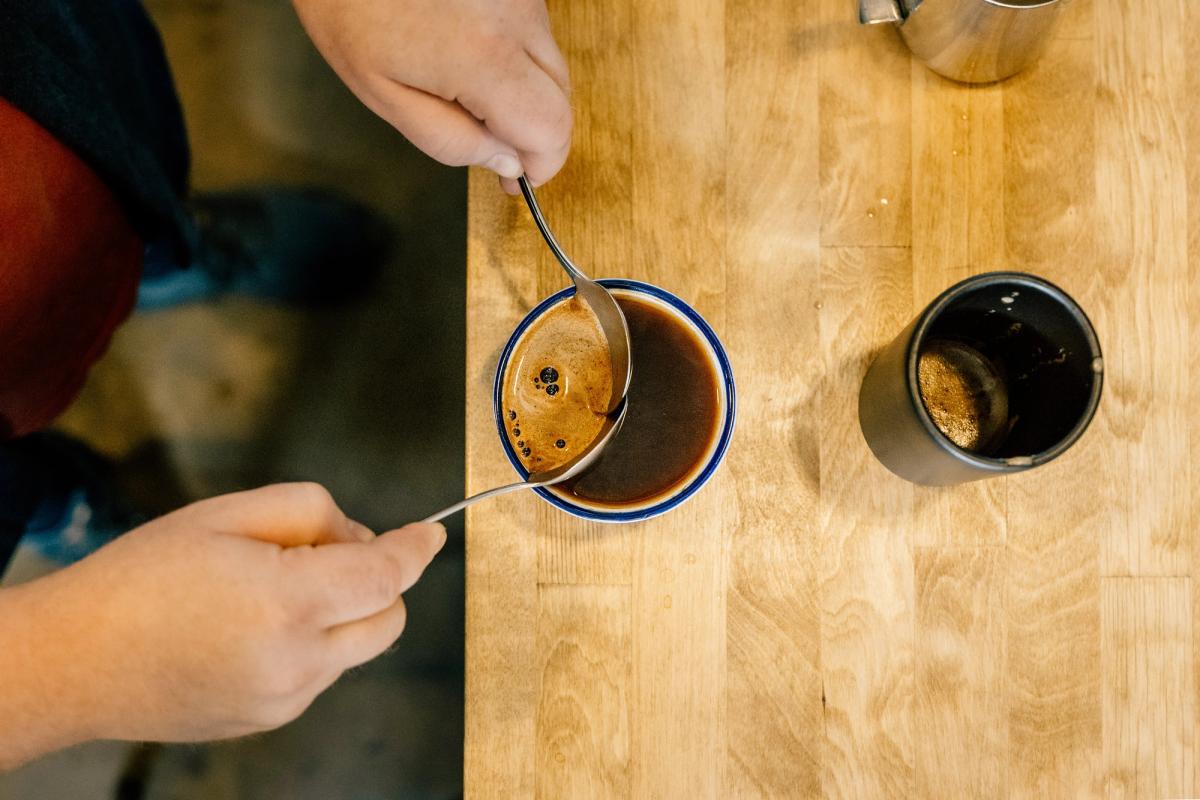Cupping at home
Taste and evaluate coffee just like the professionals do, from the comfort of your home kitchen.
"Cupping" is a standardized brew method within the coffee industry that enables a taster, or a group of tasters, to efficiently and comparatively evaluate the quality of multiple samples.
By following a set of protocols codified by the SCA (Specialty Coffee Association), cuppings limit variables and promote repeatability to ensure that the intrinsic sensory qualities of the coffees being tasted are assessed as objectively as possible.
While certainly a brew method that originated in the coffee trade, cupping is a simple (and fun!) way to enjoy tasting coffee, whether you're an industry veteran or specialty coffee novice. This brew guide will cover everything you need to know to start cupping coffee at home.

What you'll need
- Passenger Coffee
- Coffee grinder
- Digital scale
- Timer
- Two cupping spoons or large soup spoons
- Clean filtered water
- If you don’t have access to filtered water at home, we find Deerpark brand water works great for cupping. Avoid distilled water.
- A set of small glass or ceramic bouillon bowls, cups, or other shallow, wide-mouthed vessels that hold 7 - 9 oz of water
- You will want a minimum of one dedicated cup for each different coffee you plan to taste, as well as two to three additional cups for rinsing and skimming.
Preparation instructions
- Bring filtered water to ~210f, or just off boil, in a kettle. You will need 200g (7 oz) of water per sample cup, as well as enough water to fill your rinsing cups about three quarters of the way full
- Weigh out and grind 13g (~.5 oz) of coffee on a medium-fine setting into your cupping vessel(s). A grind setting slightly coarser than table salt is a good target.
- At this point you can smell and assess the ‘dry fragrance’ of the ground coffee and record any quantitative or qualitative notes you may have.
- Once you’ve assessed the dry fragrance, start your timer and immediately begin pouring 200g (7 oz) of water in each cup, ensuring that all grounds are visibly saturated.
- At this time you can assess the ‘wet aroma’ of the coffee by smelling the wet grounds and record any quantitative or qualitative notes you may have.
- When the timer reaches 4 minutes it’s time to ‘break the crust’ (continue to leave your timing counting up)
- Using the back of your spoon, do a shallow dip into the crust of the coffee at the front of the cup and push the crust backwards towards the back of the cup, and repeat this motion three times, smelling the aromas that emerge.. You will notice that the suspended grounds mostly fall to the bottom of your cups. Rinse your spoon in your rinse cup(s) between each sample.

- After the break, ‘scrape’ or ‘clean’ the cups of any remaining grounds, oils, etc, floating on top of the liquid.
- Using one spoon in each hand, starting at the back of the cupping vessel, slowly move each spoon in a circular fashion across the surface of the liquid towards the front of the cup, picking up any oils and solids along the way. Rinse your spoons in your rinse cup(s) between each sample.
- Empty and replenish your rinse cups with clean hot water
- Once your timer reaches at least 15 minutes, you’re ready to begin tasting! You may find that closer to 20 mins is a more appropriate temperature to begin tasting the coffee. Begin based on your own sensitivity, being careful not to burn yourself.
- Gently dip your spoon to grab a sample of coffee without disturbing the grounds on the bottom.
- Slurp1 the sample from your spoon and assess the various attributes of the coffee (acidity, sweetness, body, etc.) and record any quantitative or qualitative notes you may have.
- Be sure to rinse your spoon between each sample of coffee, so as not to cross contaminate flavors across cups.
- Continue to taste the coffee as it cools. As coffee cools, you may identify different qualities, as your perception of sweetness, acidity, body, etc. will change at different temperatures.
- Why the slurp? When we slurp coffee, we‘re able to more widely distribute it over our palate and throughout our complex olfactory system. Coffee contains volatile aromatic compounds (VACs) that are rich with sensory information, and are molecularly light enough to become airborne. Slurping allows us to ‘activate’ those VACs and ensure that they thoroughly communicate their sensory information to our olfactory system.
Automatic Drip Machine
A classic method when brewing for a group or for those who prefer a hands off approach.
View the guideMatcha
A celebration of tradition and balance. Matcha is stone ground whole leaf tea from Japan, whisked together with hot water to create a frothy and centering beverage.
View the guide